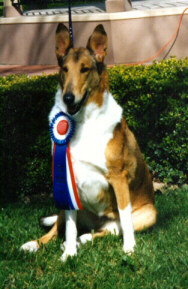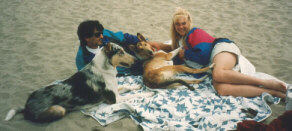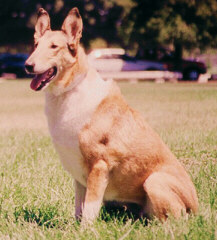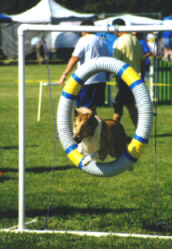by Cathy Toft, Reprinted from Collie Connection Spring 1999

Kallie at her first public appearance, at a parade of rescue collies
Photo by Melinda Sunnarborg

Kallie at her first public appearance, at a parade of rescue collies
Photo by Melinda Sunnarborg
The AWCA is founded on the premise that working is good for Collies, and this principle holds perhaps even more for rescue Collies. My first rescue Collie, Kallie, and her introduction to training convinced me of this truth beyond a doubt. I wanted to relate her story here, as it is probably typical of all too many Collies who end up in the rescue network, and it might be of some help to others who are doing rescue and who are beginning training, as I did with Kallie.
Kallie was not a product of a puppy mill or backyard breeder. You would recognize the names of her breeders. When I ordered her 3-generation pedigree from AKC, I felt that I should ask her for her autograph. Both of her parents are champions. I found pictures of her dam, full brother, granddad and great-granddad in the CCA Yearbook. An uncle took BOB at Westminster. Yet this star-studded pedigree did not improve the quality of her life at all. When Kallie was born, her two co-owners were caught in the turmoil of life crises. The co-owner who had possession of her left the dogs with her husband, who had no interest in them. Kallie spent her puppyhood out in a barn, perhaps with her litter mates but with no contact with humans (other than to be fed) or adult dogs. During her crucial socialization period, she went nowhere and got no training or interaction with either dogs or people. When she was finally taken from the barn to a show, she crumpled into the quaking mass that I would become so familiar with. She was unshowable, so she was shunted from kennel to kennel with the idea she'd be a brood bitch. But because she'd never been socialized with other dogs, she became a problem fighter. There was talk of putting her down.
By the greatest stroke of luck, Kallie was noticed and picked up by an aggressive Collie rescue organization. She was presented to me as dog that needed a lot of love (very true) but because she had behavioral problems (i.e., the fighting) she needed a home with no other dogs. She was my first dog in about 25 years. I was ecstatic the day her foster mom brought her over. It was love at first sight for both of us.
 Kallie 2 weeks into rescue, with her foster parents, Michelle and Terry Duncan and their Collie Scout, for a 4th of July picnic on the beach. Kallie was supposed to have "behavioral problems" but Michelle knew that Kallie just wanted to be loved.
Kallie 2 weeks into rescue, with her foster parents, Michelle and Terry Duncan and their Collie Scout, for a 4th of July picnic on the beach. Kallie was supposed to have "behavioral problems" but Michelle knew that Kallie just wanted to be loved.
When Kallie entered Collie rescue, she was 4-1/2 years old. She did not know her name; she didn't know what a name was. She obviously knew not a single command; again, she had no idea that humans made sounds of importance to dogs and that dogs and humans could do things together based on these sounds. I had never trained a dog (I don't count our confused childhood pets as having had any form of training). The two of us had a great deal to learn together.
I started by trying to teach her to sit on command. I was at a loss with a dog who could not sit on command--the pet dogs of my childhood seemed to do this naturally. It took me 6 weeks to teach her to sit on command. I look back on this and cringe for Kallie--it took me about 3 two-minute sessions with a clicker to teach Babe, my most recent rescue Collie and orders of magnitude worse off than Kallie, to sit on command. I had no clue about the modern methods for teaching dogs. Kallie was totally confused why I would stand over her and push her bottom to the ground, repeating this strange sound "Sit, Sit, Sit, Sit". She reacted as she did to nearly everything, by crumpling to the ground, becoming a quaking mound and dribbling (or pouring) urine. I had no idea how to react or what to do with a dog like this.
I enrolled us in the first available obedience class, which started a couple of months after I got Kallie. It was a typical garden-variety beginning obedience class. We were all totally clueless and handed as our major tool for training a choke chain attached to 6' leather leash. Jerking and praising was our method of training. But as luck would have it, our trainer was an experienced competitive obedience handler of the old school that competitive obedience should be fun and open to everyone, even us. She pushed the use of food for everything. And with the greatest luck of all, our trainer had had a pet Collie as a child, and her obvious love of Kallie--just because Kallie was a Collie--poured onto Kallie and made a big impression on my frightened dog. Kallie came to adore the class, and by the end of the session, she surged over the hill, barking and springing with joy and pulling me onto the tarmac with all her might.
About half-way through this class, I witnessed a truly special moment that I will remember for the rest of my life. It was a moment of Great Enlightenment both for me and Kallie. We were all in the classical line-up, doing our sits and downs. On the 3-minute down stay, I was 6 feet away, watching Kallie. I saw her do a bit of a double-take and glance over her left shoulder. What she saw was a line of dogs, on a down just like her, and a line of handlers all chanting Down! Stay! just like me. Then she swung her head around and looked over her right shoulder, witnessing the same sight. Then she slowly turned her head back toward me, and her eyes locked with mine. She had the most incredible expression on her face--it was truly the light bulb coming on. Her prick ears were straight up; her eyes were glowing. She had a big Collie grin on her face. She understood.
 Kallie on at a sit stay at the start line in agility, watching me intently for the signal to GO.
Kallie on at a sit stay at the start line in agility, watching me intently for the signal to GO.
And I understood too, suddenly. She understood the concept of training, and then so did I--I understood that training a dog is not just teaching them a bunch of things to do. It's not just a human being in charge. Training is a way of life for the dog. Training is their relationship with you, the trainer. Training can enrich their lives in so many ways. For Kallie, training opened her mind and provided the security and safety and structure she so needed. Training would unlock her personality and bring her incredible joy for many years to come. And as has happened with all of us, training dogs became a way of life for me too--I was a born-again dog person!
We didn't suddenly transform that night, however, but rather we grew gradually into a training lifestyle. I trained Kallie for obedience for a long time. Kallie is now 9 and will go for her CD this summer. But if I put off obedience, I put off even thinking of starting her in agility. I was totally convinced that a dog that spent the first six months I had her quaking behind the toilet in the back bedroom whenever anyone came to the door could NEVER go over an A-frame!! She wouldn't even jump up on the couch, how could she possibly jump over hurdles or through tires? She would not climb more than 3 stairs--how would she ever go over the dog walk or teeter totter? Maybe weavepoles I thought, but nothing else would be within her reach. Are you laughing yet? I hope that you are all in hysterics, because as you know nothing could be farther from the truth.
Nothing is better than agility, I now think, to start an insecure dog on the road to recovery. It is so much fun. Everything is  positive; everything is an accomplishment. But best of all, the dog is persuaded to do many scarey things and see how easy it is to succeed. And it gives the dog a physical outlet to burn off anxiety and fear. Agility also builds teamwork and trust between dog and handler. Unlike obedience, the dog must work far from the handler and make decisions on its own. While obedience is clearly teamwork too, the dog has greater responsibility in agility, I think. Although you tell the dog the course, the dog must gage all the jumps and turns and entries herself to keep up accuracy and speed.
positive; everything is an accomplishment. But best of all, the dog is persuaded to do many scarey things and see how easy it is to succeed. And it gives the dog a physical outlet to burn off anxiety and fear. Agility also builds teamwork and trust between dog and handler. Unlike obedience, the dog must work far from the handler and make decisions on its own. While obedience is clearly teamwork too, the dog has greater responsibility in agility, I think. Although you tell the dog the course, the dog must gage all the jumps and turns and entries herself to keep up accuracy and speed.
 If obedience made Kallie happy, agility turned her into a wild woman, even a brat. Far from having trouble doing any of those obstacles I most feared, she flew over the A-frame. One agility lesson, Kallie knocked me over to take a wrong-course to the teeter-totter. She took the teeter-totter five times that day, never when I asked her to. I found that far from being unable to do agility, Kallie was more dog than I could handle with my beginner level of skills. She would fly onto the course some days, leaving me in the dust. I had to train athletically myself to keep up with her. And finally, as you know, the weavepoles are the hardest thing to do in agility, but after a year of training, Kallie got those too and hits them with that wonderful rhythm you see in dogs putting their all into the course.
If obedience made Kallie happy, agility turned her into a wild woman, even a brat. Far from having trouble doing any of those obstacles I most feared, she flew over the A-frame. One agility lesson, Kallie knocked me over to take a wrong-course to the teeter-totter. She took the teeter-totter five times that day, never when I asked her to. I found that far from being unable to do agility, Kallie was more dog than I could handle with my beginner level of skills. She would fly onto the course some days, leaving me in the dust. I had to train athletically myself to keep up with her. And finally, as you know, the weavepoles are the hardest thing to do in agility, but after a year of training, Kallie got those too and hits them with that wonderful rhythm you see in dogs putting their all into the course.
Now that I think of it, I haven't seen Kallie quaking in so long--I can't remember the last time I saw her quake, actually. She is transformed into a Working Collie! And we can't end her story without thanking some special Working Collie friends who believed in us and helped Kallie in her training along the way. Many thanks to Judy Cummings, Sue Larson, Sarah Berrend, Diane Hemphill, Melinda Sunnarborg, Jean Roberts and Tara Edmonson of our AWCA--without you Kallie would not be where she is today.

A couple of months after earning her Novice titles, Kallie was diagnosed with lung cancer. A tumor filled the middle lobe of her lung. She went into surgery to remove that lobe, and her prognosis was about as good as it gets: the tumor was primary and well defined, and no lymph nodes were affected. She bounced back from surgery remarkably quickly, amazing the veterinarians and staff at Sacramento Animal Medical Group. Within one week of returning home from her surgery, she was running her daily mile. We had entered one obedience trial that we had to miss because of her surgery, but we hardly skipped a beat in her training for her Novice obedience title--our next goal after she got her agility titles. We entered the California Collie Fancier's Collie specialty AKC obedience trial in early November 1999. She took first place in Novice A and won a wonderful, large trophy with a Collie on top! We did so well the next weekend at a fun match that I entered a bunch of shows that fall to finish her title.
Then, the day after the trial entries closed, Kallie suffered a severe infection and high fever that left her in acute kidney failure. People had told me during her lung cancer that cancer was curable and not the worst thing that could happen. I scoffed at the idea at the time, but they were right. Kallie spent 9 days in the hospital and took no food or water for 10 days straight. She did not respond to aggressive fluid therapy in the hospital, so the day before Thanksgiving, Kallie was released from the hospital with a poor prognosis--but a great attitude. She barked and barked for joy that evening, when I took her home and out to the back yard. For the first week, she was barely able to walk to the end of the block and back, but within the next two weeks, she once again was running her daily mile. She had an esophageal tube inserted surgically into her stomach, because she would not eat on her own, a symptom of her kidney failure. I prepared special foods, fed her many times a day through her tube, took her everywhere with me because she had to urinate so often and eat so often, and changed the wrap around her feeding tube daily. Gradually, her kidneys began to heal, once again amazing her veterinarians. On January 15, 2000, she celebrated her 10th birthday in style.
By January, she felt so good I began to train her again for obedience, an activity tthat she loved. We entered a Collie tournament in late January, where she could compete with her feeding tube because it was not an AKC trial. She was rusty but pranced on her toes during the heeling, she was so happy to return to the ring. She took 2nd place that day. In February, she was feeling good enough to have her feeding tube removed, and so I immediately entered her in the next obedience trial, which was a UKC 3-trial weekend in March. We entered all three trials--I was taking no chances about getting her obedience title as soon as possible. Again, she was rusty, because we had hardly trained since November (given her health, mine and the weather!), but in the 3 trials, she took 1 first place and 2 second places. Best of all, Kallie won the club's new "high combined for the class" award, because she was the only Novice dog, A or B, who qualifed all three trials in the weekend. I was beaming with pride for Kallie when we entered the ring to accept the award--our "moment in the sun." Doing three trials in one weekend was much more strenuous than I had imagined it would be, but our years and years of training paid off in spades--we made mistakes but she stayed the course when all of the other dogs quit at least once under such pressure. That day she became U-CD Kallie and I officially retired her from competition.
Kallie continued to thrive that summer, her kidneys progressively healing until her blood nitrogen was normal. She entered agility matches, jumping at a lower, more comfortable height than she was allowed in competition. Then at the end of the summer we got the grim news that her cancer had metastasized in her lungs and the growing tumors began to bother her damaged kidneys and other organs. Nevertheless she stayed active, running her daily mile and keeping her stoic, upbeat attitude in the face of physical discomfort. That next Christmas, of 2000, I assumed would be her last, and she celebrated her 11th birthday on January 15, 2001. But despite a health setback here or there, Kallie lived life to the fullest, insisting on that daily run, which become a speed walk, which became a leisurely walk...
One day in mid November 2001 after a long period of feeling good, Kallie suffered another crisis, I suppose precipitated by her growing tumors. She spiked a fever that hit her kidneys hard. At last, she could not bounce back, but she kept holding onto life fiercely. Although declining rapidly, she refused to give up and spent Christmas of 2001 with my extended family (human and canine). Finally, in early morning of December 27, 2001, her spirit was as strong as ever but her body failed her, two weeks shy of her 12th birthday.